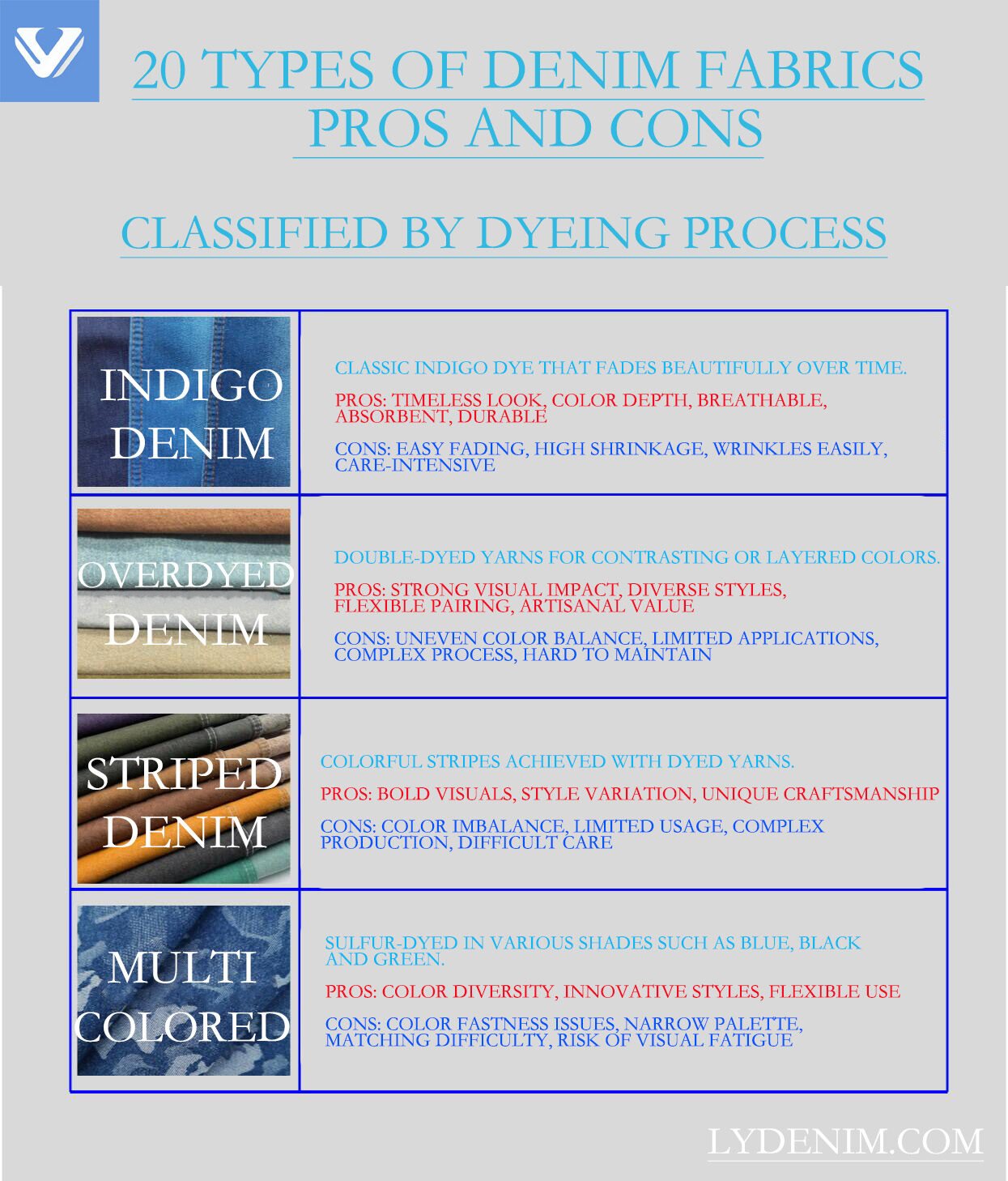Analysis of 20 Types of Denim Fabrics

Estimated Reading Time: 15-20 minutes
Introduction
Denim, a timeless staple in fashion, is celebrated for its durability and versatility. However, not all denim fabrics are the same. Understanding their pros and cons is essential for designers, manufacturers, and consumers. This article explores 20 types of denim fabric, helping you choose wisely.
Classified by Special Technology or Effect
1. Slub Denim
Woven with slub yarn, featuring irregular textured patterns for a vintage look after washing.
Pros: Unique appearance, soft and comfortable, breathable, moisture-absorbent, highly processable
Cons: Limited durability, prone to shrinkage, unstable color fastness, higher cost
2. Super Indigo Denim
Specially dyed for deeper color, offering vibrant wash effects.
Pros: Rich color, high color fastness, unique wash effects, enhanced texture
Cons: Initial fading, high production cost, limited color options, potential skin irritation
3. Crinkle Denim
Uses tightly twisted yarns to create a wrinkled effect, distinctive in look and feel.
Pros: Unique texture, comfortable and breathable, wrinkle-resistant, moisture-absorbent
Cons: Prone to deformation, high maintenance, limited durability, moderate stability, higher cost
4. Flocked Denim
Surface flocking adds softness, warmth, and style.
Pros: Diverse colors and flocking, warm and wear-resistant, soft and comfortable
Cons: Sheds easily, hard to maintain, attracts dust, poor breathability, high cost
5. Coated Denim
Coated with special layers for waterproofing or UV protection.
Pros: Protective features, durable, easy to clean
Cons: Poor breathability, limited flexibility, wears out easily, hard to maintain, non-degradable

Classified by Special Technology or Effect
Classified by Weave Structure
6. Plain Weave Denim
Simple one-over-one weave, tight and flat.
Pros: Tight structure, smooth surface, wear-resistant, moisture-absorbent
Cons: Stiff feel, average breathability, lacks elasticity, fades easily
7. Twill Denim
Two- or three-over-one weave, soft with clear diagonal lines.
Pros: Soft feel, breathable, elastic, strong 3D effect
Cons: Weaker wear resistance, prone to deformation, lower color fastness, texture limitations
8. Broken Twill Denim
An alternation of twill patterns, breaking the diagonal lines to create unique textures.
Pros: Soft feel, breathable, moisture-retentive, unique structure, heat/alkali resistant
Cons: Less durable, prone to deformation, poor color fastness, complex production
9. Ribbed Denim
Raised weave patterns for bold textures.
Pros: Unique look, durable, absorbent, structured
Cons: Stiff, less breathable, dyeing difficulty, high processing cost

Classified by Weave Structure
Classified by Raw Materials
10. Combed Cotton Denim
Made with combed yarns for a smoother, stronger fabric.
Pros: Fine fibers, skin-friendly, durable, breathable, bright colors
Cons: High cost, prone to shrinkage, lacks elasticity
11. All Cotton Denim
100% cotton for natural comfort.
Pros: Breathable, skin-friendly, absorbent, eco-friendly, strong dyeability
Cons: Shrinks easily, wrinkles, slow to dry, lacks stretch
12. Interwoven Denim
Mixes various yarns for combined functional benefits.
Pros: Better elasticity, distinctive texture, moisture-wicking, UV resistant
Cons: Expensive, high maintenance, inconsistent quality
13. Blended Denim
Made from blended fibers for multi-functional use.
Pros: Elastic, quick-drying, wrinkle-resistant, unique feel, rich color
Cons: Performance varies by blend ratio, maintenance complexity, potential allergies
14. Stretch Denim
Combines cotton and spandex for added flexibility.
Pros: Comfortable fit, shape retention, style flexibility
Cons: Shorter lifespan, needs careful care, less stable, reduced breathability
15. Silk Denim
Features silk for a glossy, luxurious feel.
Pros: Glossy, soft, breathable, absorbent, wrinkle-resistant
Cons: Hard to care for, less durable, expensive
16. Varied Yarn Denim
Uses yarns of various thicknesses for rich textures.
Pros: Textured look, visual depth, balanced performance
Cons: Complex to produce, high cost, inconsistent yarn quality

Classified by Raw Materials
Classified by Dyeing Process
17. Indigo Denim
Classic indigo dye that fades beautifully over time.
Pros: Timeless look, color depth, breathable, absorbent, durable
Cons: Easy fading, high shrinkage, wrinkles easily, care-intensive
18. Overdyed Denim
Double-dyed yarns for contrasting or layered colors.
Pros: Strong visual impact, diverse styles, flexible pairing, artisanal value
Cons: Uneven color balance, limited applications, complex process, hard to maintain
19. Striped Denim
Colorful stripes achieved with dyed yarns.
Pros: Bold visuals, style variation, unique craftsmanship
Cons: Color imbalance, limited usage, complex production, difficult care
20. Multi-Colored Denim
Sulfur-dyed in various shades such as blue, black, and green.
Pros: Color diversity, innovative styles, flexible use
Cons: Color fastness issues, narrow palette, matching difficulty, risk of visual fatigue

Classified by Dyeing Process
Other Types
21. Custom Denim Fabric
Tailored to meet specific performance or design needs.
Pros: Flexible customization, functional and aesthetic precision
Cons: Long lead times, high cost, minimum order quantities
How to Choose the Right Denim Fabric?
-
Purpose: Match fabric type with garments like jeans or dresses
-
Style: Pick based on texture, weave, and color
-
Comfort: Prioritize softness and breathability
-
Durability: Consider wear resistance and color retention
-
Cost: Balance quality with budget
Customization Services by LYDENIM
🎨 Want custom denim fabrics or unique custom denim garment? LYDENIM specializes in tailor-made solutions to meet your design and production needs.
🛍️ Explore & Get Inspired: Browse our fabric selections and discover design ideas on LYDenim.
🌐 Elastic Clothing: Check out our offerings on MyAlibaba. 📩 Contact Us: Reach out at malone@lydenim.com.
Create your denim masterpiece with LYDENIM—your trusted partner for stretch fabric and custom denim solutions.
